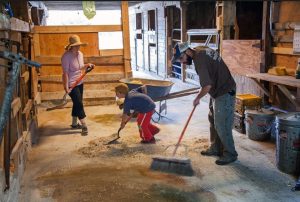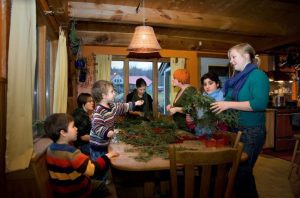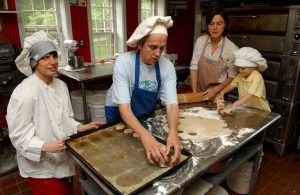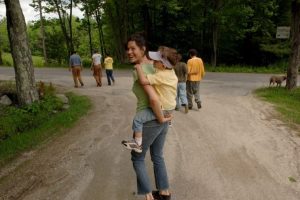It was nearly 35 years ago when I walked into a Waldorf kindergarten classroom for the first time. Beauty met me at the threshold and beckoned me forward. The kindergarten was in a small “pioneering” school. The building itself, above a business in the midst of an urban setting, wasn’t pretty. The furniture wasn’t new. The carpet was shabby. Yet a rosy glow warmed me and the space was awash with veils of color.
Something that looked like an altar made me gasp at the mystery, grace and loveliness of nature that radiated from it. In every corner of the room true objects, true colors and true shapes fed my senses and instilled in me a feeling of peacefulness coupled with an impulse to step forward, interact with these surroundings, and engage with the beauty around me.
A person approached – this was the kindergarten teacher (on an Open House day with no children in the room). I asked her about the qualities of the space. She said something like, “In Beauty one feels well.” This moment changed the course of my life.
Beauty draws us in. It beckons us to engage. And so I did. I enrolled my toddler in the school… and I became a Waldorf class teacher. I experienced and learned: thinking, feeling and willing; science, art and religion; truth, beauty and goodness.
As a class teacher I was called upon to guide the children in their self-becoming through the portal of art and feeling for beauty. I painted classrooms following insightful recommendations on the ability of certain colors at certain ages to awaken the child to the world in a manner harmonious to her unfolding being. I learned to open myself to observing the beauty in nature. I learned how human hands, both large and small, can create great beauty.
Through the portal of wonder and observation whispers of the most sublime, wisdom-filled, and divine aspects of the living world around us began to open. Thus beauty became a teacher of mine. Under its tutelage my awe, wonder and sense of being part of a whole so much grander than myself has grown continually. The beauty of nature bestows upon me, through its incredible grace, peace and a sense of belonging.
In their fifth grade year, a year of beauty and harmony, children are so balanced and beautiful and there, amidst the sensing of ancient Greece, echo the final lines of John Keats’s “Ode on a Grecian Urn”:
“‘Beauty is truth, truth beauty,’ – that is all
Ye know on earth, and all ye need to know.”
Like feeling, which mediates between willing and thinking, beauty stands between goodness and truth. Beauty then can reveal to us both what is good and what is true.
Beauty rejuvenates. Beauty awakens joy. But why? Knowing beauty became a quest. Many have written of the special power of beauty. In philosophy Beauty, along with Truth and Goodness, is considered a transcendental, or something that lies beyond ordinary or common experience.
In his 1923 lecture titled “Truth, Beauty and Goodness,” Rudolf Steiner’s insights are revelatory. He speaks of Truthfulness as keeping intact the threads that bind us to our pre-earthly existence in the world of pure Spirit, which then allows us to carry in ourselves a sense of existence that is much deeper than the external circumstances we encounter.
Within this expanded sense of self a longing or sadness can arise. “It is a sadness that can only find consolation if the sense of beauty is awakened in the soul. Beauty gives us joy once more.” Beauty lives in the present as a salve. “To glow in response to beauty means that in his soul man must create in a picture, at least, a new link with pre-earthly spirituality.”
 “A genuine feeling for beauty forges a link that binds us here, in earthly life itself, once again with pre-earthly existence. We ought never to undervalue the significance of beauty in education and in outer culture. A civilization that is filled with ugly machines, with chimneys and smoke, and dispenses with beauty, is a world that makes no efforts to forge a link between man and pre-earthly existence; indeed, it tears him asunder.”
“A genuine feeling for beauty forges a link that binds us here, in earthly life itself, once again with pre-earthly existence. We ought never to undervalue the significance of beauty in education and in outer culture. A civilization that is filled with ugly machines, with chimneys and smoke, and dispenses with beauty, is a world that makes no efforts to forge a link between man and pre-earthly existence; indeed, it tears him asunder.”
– Rudolf Steiner, “Truth, Beauty and Goodness” (January 19, 1923)
Our culture today, much of which has a purely material approach, often treats beauty as a commodity – something you can buy in a tube, preserve through technology, or define based on superficial norms of the moment rather than careful, true observation of what lies beneath the surface. In the adolescent, this commodified perspective on beauty can lead to self-criticism and despair.
 Alternatively, creating something of beauty – from a carved wooden bowl to a portrait in watercolor – and spending time in nature’s beauty instill self-confidence, engender a sense of belonging, and awaken a feeling for a self-directed future. For youth in adolescence, connecting with natural beauty and creating beauty of one’s own contribute to a powerful and empowering realization: “I can be the good I wish to see in the world.”
Alternatively, creating something of beauty – from a carved wooden bowl to a portrait in watercolor – and spending time in nature’s beauty instill self-confidence, engender a sense of belonging, and awaken a feeling for a self-directed future. For youth in adolescence, connecting with natural beauty and creating beauty of one’s own contribute to a powerful and empowering realization: “I can be the good I wish to see in the world.”
Living in beauty and creating the beautiful through artistic practice hold us in the present. These activities help bring joy and enthusiasm to the internal longing that comes with our search for Truth. And they warm our hearts so we may bring goodness forward toward our fellow human beings.
 In my own journey I found myself, after many years of class teaching, walking along a path at Plowshare Farm, an anthroposophic lifesharing community nestled in the woods of southern New Hampshire where people with and without developmental disabilities live, work, eat and play side by side, acting as co-creators in the shared endeavor of building a caring, inclusive and sustainable community.
In my own journey I found myself, after many years of class teaching, walking along a path at Plowshare Farm, an anthroposophic lifesharing community nestled in the woods of southern New Hampshire where people with and without developmental disabilities live, work, eat and play side by side, acting as co-creators in the shared endeavor of building a caring, inclusive and sustainable community.
As before, it was Beauty who caught my attention and planted a seed of intention.  As I walked along that path I could hear, behind the trees, animals and people, an infectious sound: it was the joyful play of children. At that moment it struck me that I could not imagine a more wholesome way for children to grow than in a place where the senses are nurtured, where beauty lives and where the pure spirit in every human being is celebrated.
As I walked along that path I could hear, behind the trees, animals and people, an infectious sound: it was the joyful play of children. At that moment it struck me that I could not imagine a more wholesome way for children to grow than in a place where the senses are nurtured, where beauty lives and where the pure spirit in every human being is celebrated.
In our earthly strivings we are reminded, through beauty, to live in the present with simultaneous awareness of the spiritual and the earthly. This awareness of Spirit allows us to see in ourselves, and in others, the pure, eternal spirit, which is always well.  On earth we each carry our own shortcomings – weaknesses, blind spots, disabilities. Some members of the community here at Plowshare – the place I have now called home for more than 15 years – face deep earthly challenges stemming from developmental special needs. Yet it is these same people who have helped me see more clearly the beauty of pure Spirit that lives in each of us, inspiring and guiding me on the transformative path toward goodness.
On earth we each carry our own shortcomings – weaknesses, blind spots, disabilities. Some members of the community here at Plowshare – the place I have now called home for more than 15 years – face deep earthly challenges stemming from developmental special needs. Yet it is these same people who have helped me see more clearly the beauty of pure Spirit that lives in each of us, inspiring and guiding me on the transformative path toward goodness.
Kimberly Dorn was a Waldorf class and Extra Lesson teacher in California and New Hampshire prior to joining Plowshare Farm (www.plowsharefarm.org), an anthroposophic lifesharing community in Greenfield, New Hampshire. Plowshare is a Camphill affiliate and a member of the Anthroposophic Council for Inclusive Social Development. Kimberly can be reached at kimberly@plowsharefarm.org.